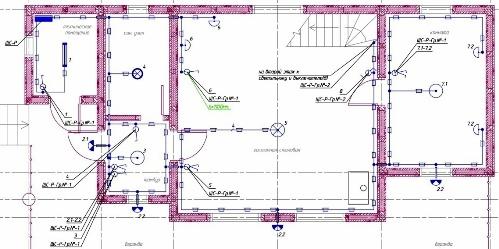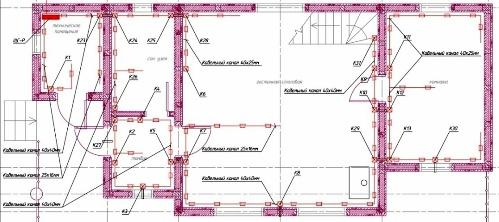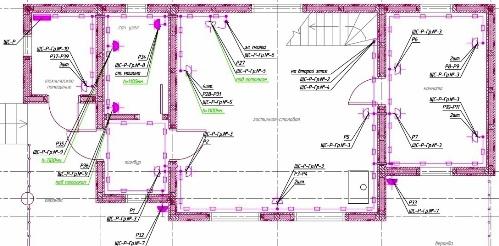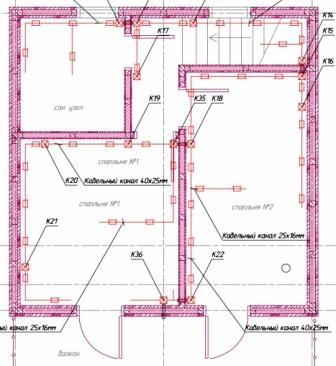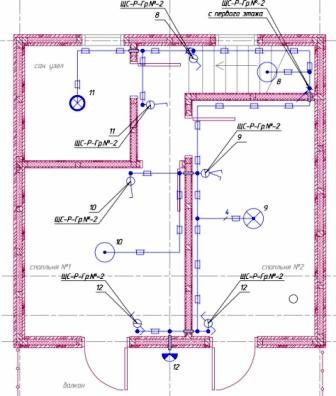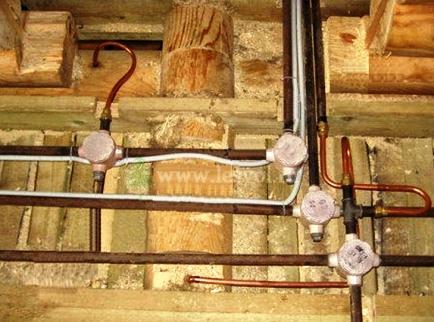Categories: Featured Articles » Electrician at home
Number of views: 54973
Comments on the article: 5
Wiring in a wooden house - types and cost of work
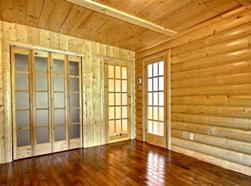 In recent years, many of our compatriots, starting the construction of their own houses, give preference to classic log houses. And this is understandable, because these are environmentally friendly buildings made of natural materials.
In recent years, many of our compatriots, starting the construction of their own houses, give preference to classic log houses. And this is understandable, because these are environmentally friendly buildings made of natural materials.
However, all wooden buildings have one serious drawback, namely a high degree of combustibility of the source materials. Statistics of the Ministry of Emergencies shows that the main cause of the fire of buildings made of wood is a faulty electrical wiring. That is why strict and mandatory requirements are imposed on the electrical installation in wooden houses.
If you plan to build a wooden house, then the priority will be the installation of electrical networks of the future home. You must understand that the quality, and most importantly the correctly completed installation of electrical wiring, is a guarantee of your continued comfortable and safe stay.
In this article, we will try to reveal such a topic as electrical wiring in a wooden house. Let us dwell in more detail on the advantages and disadvantages of various types of installation of electrical wiring, as well as on possible financial costs. You will have the opportunity to compare several wiring methods and choose the most suitable for you.
An example would be a typical two-story log house with an area of 245 square meters.
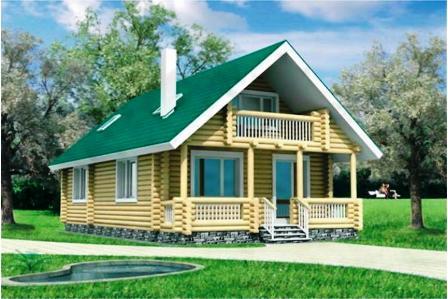
For clarity of all the calculations made, we bring to your attention a plan diagram of the electrical wiring in the specified house.
1st level (click on the picture to enlarge):
Lighting Scheme:
Electric circuit:
Outlet layout:
2nd level (click on the picture to enlarge):
Electric circuit:
Lighting Scheme:
Outlet layout:
Next, we consider in more detail the most popular types of wiring in wooden houses.
Electrical installation in PVC boxes
Ideal conditions for cooling electrical wiring;
Simplicity and convenience of wiring;
Unlimited access to electrical wiring and the ability to replace individual sections;
The ability to connect additional points of electrical power.
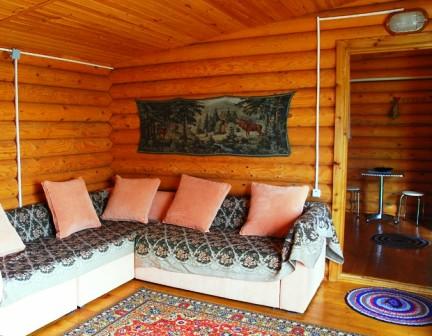
However, this method also has certain disadvantages, in particular, when the structure shrinks, damage and deformation of plastic boxes is possible. In this case, you will need to re-install the electrical wiring in a wooden house, in separate areas. In addition, visually such electrical wiring is not entirely attractive and creates a certain contrast in a log house.
Electrical installation in PVC boxes with wall sheathing
This method is used as an alternative. Cladding the walls with lining and installation in PVC boxes is usually carried out for one simple reason. Often a person, having built a house and starting electrical work, is faced with a high price offer for electrical work.
So, for example, the cost of wires for retro wiring is an order of magnitude higher than usual, etc. However, the total cost figures for this method are not very different from other types.
According to experts, for log homes, this is not the best option. It is impractical to build a log house in order to subsequently sheathe it with a lining.
Note: If you plan to sheathe the house from the inside with a clapboard, all electrical wiring must be carried out using a special metal corrugated pipe. This method of laying wires is reliable and meets the requirements of fire safety.
If you chose this particular method of electrical installation in a wooden house, you should understand that the processing of logs, the style of felling and the features of the technology of folding the house will no longer have any significance from the point of view of aesthetics, all this will be hidden under the lining.
Installation by means of insulators, or retro wiring
This method of electrical installation has several advantages and is an average option for cost. For example, the shrinkage of the structure does not affect the condition of the electrical wiring. Even if the wire sags somewhere, it is easy to pull it up and bring it into proper form.
The location of all electrical points can be determined after completion of construction. In addition, you can easily replace faulty switches and sockets or their locations.

As for the disadvantages of this method, first of all, it is an abundance of wires. So in some places you can have up to five or more separate wires, not to mention putting them into a power shield, which in turn does not look pretty.
Concealed wiring
In accordance with clause 7.1.32 of the PUE instruction, in wooden houses, flush mounting is permissible only with the use of metal pipes. A hidden method of installing electrical wiring in wooden houses is a time-consuming and, accordingly, the most expensive process. However, from the point of view of designers, this method is most attractive.
Installation of the main lines of electrical wiring is carried out at the construction stage, before laying floors and ceilings. Electric wires are laid in steel pipes, and lifts for switches, sockets and fixtures are carried out in vertical holes in the wall.
The main task at this stage is to accurately determine the intended location of electrical appliances in the house. This installation method assumes that all communications will be hidden, and further adjustment of electrical points is quite complicated. In other words, you will not be able to transfer or add another outlet without significant violations of the home interior.
For further installation work, it is necessary to draw up a plan for drilling vertical holes, which is implemented in accordance with the plan for the location of consumers of electric current.
Important when performing flush mounting:
First of all, you must ensure that your building is properly insulated or use the most thick lumber, not less than 240mm. It is no secret that in the case of freezing of house building, metal pipes begin to produce condensate, which causes rotting of the tree.
Here, of no small importance is the ability to determine the dew point, or, in other words, the temperature at which condensation occurs and, based on this, arrange the pipes with the necessary deepening in the wall. And also for this, insulation materials are selected in accordance with the heat engineering calculation. It is important to note that not every specialist can make such calculations.
It is also necessary to consider issues related to real estate insurance. The cost of our homebuilding (245 sq. M.) At the moment will amount to approximately 6 million rubles, respectively, it must be insured.
If serious fire safety violations are discovered, you may be denied property insurance. Even with the consent of the insurer, serious violations of safety standards may subsequently become a reason for refusal of insurance payments in the event of an insured event.
What to choose, or resume specialists
According to experts, for a wooden house, the most suitable option is to combine the two methods of electrical installation. In particular, this is retro-style wiring and a hidden installation method. Where you can hide the electrical wiring in the floors or in the floor, the wires are hidden, and where there is a need for wiring on the wall, you can use a retro wire.
Comparative analysis of the methods and cost of wiring in a wooden house:
Materials
I
Mounting hidden in metal pipes
III
* The average cost on the Internet, also the calculation does not indicate the cost of nails, insulation, self-tapping screws, etc.
a) total price
b) price with lining
b) 334 426 rub
* Average cost on the Internet.
It should be noted that for analysis and consideration we took electrical appliances and products included in the same price category, but in different mounting variations. The list includes products from leading manufacturers of electrical wiring in retro style from Southeast Asia and Europe. Please note that the brands presented here are the leading brands in the domestic market.
Conclusion:
What method of electrical installation you would not choose, you should understand that a wooden house is made of very combustible materials. And gross violations of wiring rules can lead to the most sad consequences. Wiring in a wooden house, this is not the case when you can save.
Experts recommend trusting such work only to qualified specialists who have relevant experience, and also use only high-quality components and materials. Entrust the work to professionals and get the desired result and maximum security.
LLC "Salvador and Co"
2014 year
See also at bgv.electricianexp.com
:

